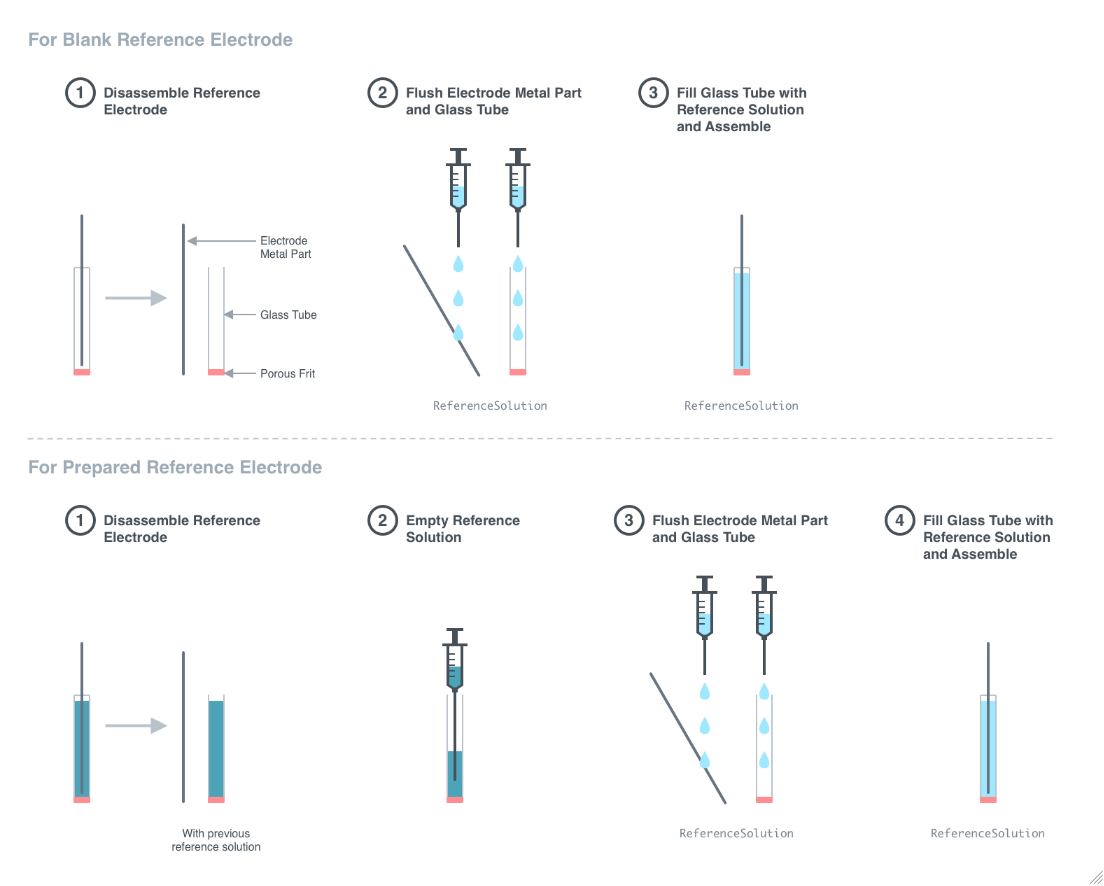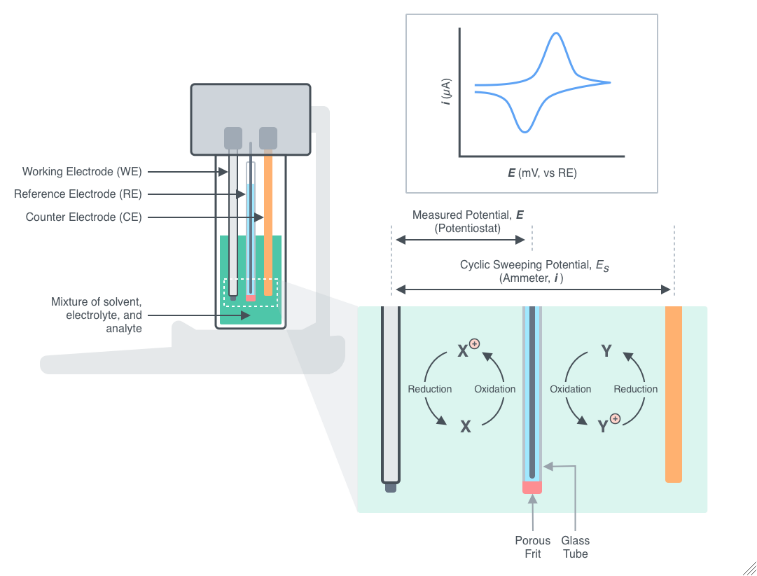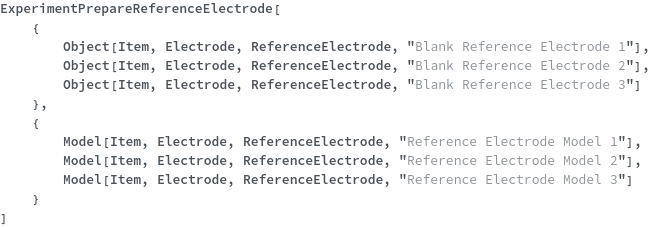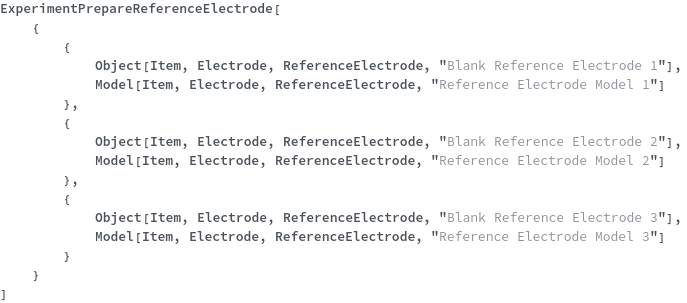Electrode Polishing
PolishReferenceElectrode
Indicates if in the presence of rust, the non-working part (the metal part that does not directly contact experiment solution) of reference electrode is polished with a piece of 1200 grit sandpaper. The working part (the metal part that directly contacts experiment solution) will not be polished, and if rust is present on the working part, the electrode's RustyLog will be updated.
Pattern Description: True or False.
Programmatic Pattern: BooleanP
Index Matches to: experiment samples
Electrode Cleaning
PrimaryWashingSolution
The solution used to wash the electrode metal wiring or plate and the electrode glass tube, after the previous reference solution (if any) is emptied and the optional polishing step is completed. This washing step helps to remove any remaining liquid or solid on the electrode metal wire or plate. A washing cycle includes rinsing the full surface areas of the electrode metal wiring or plate and the electrode glass tube (both inside and outside), with approximately 5 mL of solution.
Default Calculation: Automatically set to Model[Sample, "Milli-Q water"] if the RecommendedSolventType of the reference electrode model being prepared is Aqueous. If the RecommendedSolventType is Organic, it is automatically set to Model[Sample, "Acetonitrile, Electronic Grade"].
Pattern Description: An object of type or subtype Model[Sample] or Object[Sample] or a prepared sample or Null.
Programmatic Pattern: ((ObjectP[{Model[Sample], Object[Sample]}] | _String) | Automatic) | Null
Index Matches to: experiment samples
NumberOfPrimaryWashings
Indicates the number of washing cycles performed with PrimaryWashingSolution.
Default Calculation: Automatically set to 2 if PrimaryWashingSolution is not Null. Automatically set to Null if PrimaryWashingSolution is set to Null.
Pattern Description: Greater than or equal to 1 and less than or equal to 10 in increments of 1 or Null.
Programmatic Pattern: (RangeP[1, 10, 1] | Automatic) | Null
Index Matches to: experiment samples
SecondaryWashingSolution
The second solution used to wash the electrode metal wiring or plate and the electrode glass tube, after the primary washing step. This washing step helps to further remove any remaining liquid or solid on the electrode metal wire or plate. A washing cycle includes rinsing the full surface areas of the electrode metal wiring or plate and the electrode glass tube (both inside and outside), with approximately 5 mL of solution.
Pattern Description: An object of type or subtype Model[Sample] or Object[Sample] or a prepared sample or Null.
Programmatic Pattern: (ObjectP[{Model[Sample], Object[Sample]}] | _String) | Null
Index Matches to: experiment samples
NumberOfSecondaryWashings
Indicates the number of washing cycles performed with SecondaryWashingSolution.
Default Calculation: Automatically set to 2 if SecondaryWashingSolution is not Null. Automatically set to Null if SecondaryWashingSolution is set to Null.
Pattern Description: Greater than or equal to 1 and less than or equal to 10 in increments of 1 or Null.
Programmatic Pattern: (RangeP[1, 10, 1] | Automatic) | Null
Index Matches to: experiment samples
Reference Electrode Preparation
NumberOfPrimings
Indicates the number of priming cycles performed with ReferenceSolution defined in the reference electrode model being prepared. A priming cycle includes rinsing the full surface areas of the electrode metal wiring or plate and the electrode glass tube (only inside).
Pattern Description: Greater than or equal to 1 and less than or equal to 10 in increments of 1.
Programmatic Pattern: RangeP[1, 10, 1]
Index Matches to: experiment samples
PrimingVolume
Indicates the volume of the ReferenceSolution used to prime the reference electrode metal wire or plate and the inside of the glass tube in each priming cycle.
Default Calculation: Automatically set to the greater of 2 Milliliter or 2 times of the SolutionVolume defined in the reference electrode model being prepared.
Pattern Description: Greater than or equal to 0 milliliters and less than or equal to 20 milliliters.
Programmatic Pattern: RangeP[0*Milliliter, 20*Milliliter] | Automatic
Index Matches to: experiment samples
PrimingSoakTime
Indicates the minimum duration of the reference electrode metal wire or plate will be soaked in the ReferenceSolution within the glass tube after the last priming cycle.
Pattern Description: Greater than or equal to 1 minute and less than or equal to 15 minutes.
Programmatic Pattern: RangeP[1*Minute, 15*Minute]
Index Matches to: experiment samples
ReferenceSolutionVolume
Indicates the volume of the ReferenceSolution the electrode's glass tube is filled with. The ReferenceSolutionVolume should be within the range of 95% and 105% of the SolutionVolume defined by the reference electrode model being prepared.
Default Calculation: Automatically set to the SolutionVolume defined in the reference electrode model being prepared.
Pattern Description: Greater than 0 milliliters.
Programmatic Pattern: GreaterP[0*Milliliter] | Automatic
Index Matches to: experiment samples
Post Experiment
SamplesOutStorageCondition
The non-default conditions under which any new samples generated by this experiment should be stored after the protocol is completed. If left unset, the new samples will be stored according to their Models' DefaultStorageCondition.
Pattern Description: {AmbientStorage, Refrigerator, Freezer, DeepFreezer, CryogenicStorage, YeastIncubation, BacteriaIncubation, MammalianIncubation, TissueCultureCellsIncubation, MicrobialCellsIncubation, MicrobialCellsShakingIncubation, YeastCellsIncubation, YeastCellsShakingIncubation, ViralIncubation, AcceleratedTesting, IntermediateTesting, LongTermTesting, UVVisLightTesting} or Disposal or Null.
Programmatic Pattern: (Alternatives[SampleStorageTypeP | Disposal]) | Null
Index Matches to: experiment samples
Protocol
NumberOfReplicates
Number of times each of the input reference electrode model should be prepared using identical experimental parameters.
Pattern Description: Greater than or equal to 2 and less than or equal to 5 in increments of 1 or Null.
Programmatic Pattern: RangeP[2, 5, 1] | Null


















































































































